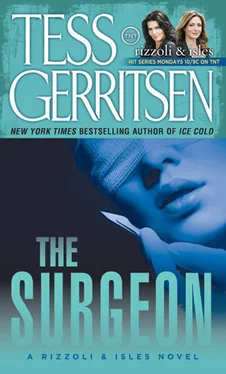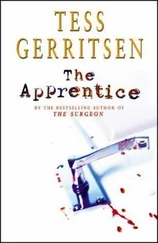“The world’s full of women. Why focus on her?”
“Unfinished business.”
“Yeah, well, I got a better theory.” Singer rose from his chair. “Cordell forgot to lock the chain on her kitchen door. Your boy in Boston is copying what he read in the newspapers. And your forensic hypnotist pulled up a false memory.” Shaking his head, he started toward the door. Tossed back a sarcastic parting shot: “Let me know when you catch the real killer.”
Moore allowed the exchange to bother him only briefly. He knew Singer was defending his own work on the case, and he could not blame him for being skeptical. He was beginning to wonder about his own instincts. He had come all the way to Savannah to either prove or disprove the partner theory, and thus far he had nothing to back it up.
He focused his attention on the TV screen and pressed Play.
The camera left the kitchen, advanced up the hallway. A pause to look into the bathroom — pink towels, a shower curtain with multicolored fish. Moore’s hands were sweating. He dreaded watching what came next, but he could not tear his gaze from the screen. The camera turned from the bathroom and continued up the hallway, past a framed watercolor of pink peonies hanging on the wall. On the wood floor, bloody shoeprints had been smeared and tracked over by the first officers on the scene and later by frantic paramedics. What was left was a confusing abstract in red. A doorway loomed ahead, the view jiggling in an unsteady hand.
Now the camera moved into the bedroom.
Moore felt his stomach turn, not because what he was staring at was any more shocking than other crime scenes he had witnessed. No, this horror was deeply visceral because he knew, and cared deeply about, the woman who had suffered here. He had studied the still photos of this room, but they did not convey the same lurid quality as this video. Even though Catherine was not in the frame — by this time she had already been taken to the hospital — the evidence of her ordeal shouted at him from the TV screen. He saw the nylon cord, which had bound her wrists and ankles, still attached to the four bedposts. He saw surgical instruments — a scalpel and retractors — left on the nightstand. He saw all this and the impact was so powerful that he actually swayed back in his chair, as though shoved by a fist.
When the camera lens shifted, at last, to Andrew Capra’s body lying on the floor, he felt barely a twitch of emotion; he was already numbed by what he’d seen seconds earlier. Capra’s abdominal wound had bled profusely, and a large pool had collected beneath his torso. The second bullet, into his eye, had inflicted the fatal wound. He remembered the five-minute gap between the two gunshots. The image he saw reinforced that timeline. Judging by the amount of pooling, Capra had lain alive and bleeding for at least a few minutes.
The videotape came to an end.
He stared at the blank screen, then stirred from his paralysis and turned off the VCR. He felt too drained to rise from the chair. When at last he did, it was only to escape this place. He picked up the box containing the photocopied documents from the Atlanta investigation. Since these papers were not originals but copies of documents on file in Atlanta, he could review them elsewhere.
Back in his hotel, he showered, ate a room-service hamburger and fries. Gave himself an hour with the TV to decompress. But the whole time he sat flipping between channels, what his hand really itched to do was call Catherine. Watching the last crime scene video had brought home exactly what sort of monster now stalked her, and he could not rest easy.
Twice he picked up the phone and put it down again. He picked it up yet again, and this time his fingers moved of their own accord, punching in a number he knew so well. Four rings, and he got Catherine’s answering machine.
He hung up without leaving a message.
He stared at the phone, ashamed by how easily his resolve had crumbled. He had promised himself to hold fast, had agreed to Marquette’s demand that he maintain his distance from Catherine for the duration of the investigation. When all this is over, somehow I will make things right between us.
He looked at the stack of Atlanta documents on the desk. It was midnight and he had not even started. With a sigh, he opened the first file from the Atlanta box.
The case of Dora Ciccone, Andrew Capra’s first victim, did not make for appetizing reading. He already knew the general details; they’d been summarized in Singer’s final report. But Moore had not read the raw reports from Atlanta, and now he was going back in time, examining the earliest work of Andrew Capra. This was where it all started. In Atlanta.
He read the initial crime report, then progressed through files of interviews. He read statements from Ciccone’s neighbors, from the bartender in the local watering hole where she was last seen alive, and from the girlfriend who discovered the body. There was also a file with a list of suspects and their photographs; Capra was not among them.
Dora Ciccone was a twenty-two-year-old grad student at Emory. On the night of her death, she was last seen around midnight, sipping a Margarita at La Cantina. Forty hours later, her body was discovered in her home, nude and tied to the bed with nylon cord. Her uterus had been removed and her neck slashed.
He found the police timeline. It was only a rough sketch in barely legible writing, as though the Atlanta detective had put it together merely to satisfy some internal checklist. He could almost smell failure in these pages, could read it in the depressive droop of the detective’s handwriting. He himself had experienced that heavy feeling that builds in your chest as you pass the twenty-four-hour mark, then a week, then a month, and you still have no tangible leads. This was what the Atlanta detective had — nothing. Dora Ciccone’s killer remained an unknown subject.
He opened the autopsy report.
The butchery of Dora Ciccone had been neither as swift nor as skillful as Capra’s later killings. Incisional jags indicated Capra lacked the confidence to make a single clean cut across the lower abdomen. Instead he had hesitated, his blade backtracking, macerating the skin. Once through the skin layer, the procedure degenerated to amateurish hacking, the blade deeply nicking both bladder and bowel as he excavated his prize. On this, his first victim, no suture was used to tie off any arteries. The bleeding was profuse, and Capra would have been working blind, his anatomical landmarks submerged in an ever-deepening pool of crimson.
Only the coup de grace was performed with any skill. It had been done in one clean slash, left to right, as though, with his hunger now sated and the frenzy fading, he was finally in control and could finish the job with cold efficiency.
Moore set aside the autopsy report and confronted the remains of his dinner, sitting on a tray beside him. Suddenly queasy, he carried the tray to the door and set it outside in the hall. Then he returned to the desk and opened the next folder, which contained the crime lab reports.
The first sheet was a microscopic: Spermatozoa identified in swab from victim’s vaginal vault.
He knew that DNA analysis of this sperm later confirmed it was Capra’s. Prior to killing Dora Ciccone, he had raped her.
Moore turned to the next page and found a bundle of reports from Hair and Fiber. The victim’s pubic area had been combed and the hairs examined. Among the samples was a reddish-brown pubic hair that matched Capra’s. He flipped through the next few pages of Hair and Fiber reports, which examined various stray hairs found at the crime scene. Most of the samples were from the victim herself, either pubic or head hairs. There was also a short blond strand retrieved from the blanket, later identified as nonhuman, based on the complex structural pattern of the medulla. A handwritten addendum said: “Vic’s mother owns Golden Retriever. Similar hairs found on backseat of vic’s car.”
Читать дальше












